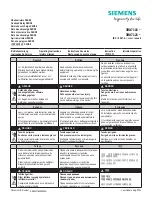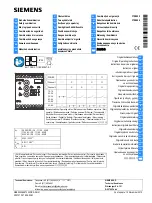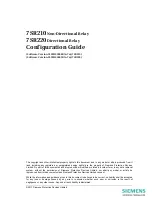
K2CM
9
LED Indicators
When the motor circuit trips due to overcurrent, open-phase, or
reverse-phase, the respective LED indicator lights (continuously).
The overcurrent indicator also indicates the start of operation.
•
With the inverse-type models, when the motor current exceeds the
overcurrent operating value, the overcurrent indicator blinks at the
bright level and then remains lit at the dimmed level. After the oper-
ating time has elapsed, with the manual resetting models, the
motor circuit trips and the overcurrent indicator remains lit at the
bright level, whereas with automatic resetting models, the indicator
remains lit at the bright level until the motor current descends below
the resetting value.
•
Since the indicator status is not stored in memory when the opera-
tion power supply is turned OFF, be sure to check which indicators
were illuminated when the motor circuit was tripped.
The functions of the K2CM can be used in the following seven com-
binations. For each function, turn ON the corresponding setting
switch.
When the setting switches for overcurrent, open-phase, or reverse-
phase function are turned OFF, the following functions becomes
invalid.
1. Overcurrent Setting Switches
These switches select the overcurrent setting and the multiplying
factor linked with operating time setting.
2. Open-phase Setting Switches
These switches select the open-phase detecting function and the
“High” or “Low” current imbalance factor for operation.
3. Reverse-phase Setting Switches
These switches select the reverse-phase detection function and
reverse-phase polarity. By selecting the reverse-phase polarity
accordingly, the K2CM can operate normally without changing the
connections when wired with the order of the phases reversed.
If the K2CM detects reverse-phase although the motor is rotating in
the forward direction (e.g., because of incorrect wiring of power
lines), set the reverse-phase polarity switch to the “Reverse” position
to enable normal operation.
Note:
The K2CM detects reverse-phase at a point before the current
transformer. If a reverse connection is made at the load side far
from the current transformer and the motor rotates in the re-
verse direction, the K2CM does not detect the reverse-phase.
Reverse-detectable Range
* The OR phase circuit in the above figure combines a resistor and
capacitor. The reverse phase detection circuit detects when the
reversed signals detected by the OR phase circuit reach the oper-
ating level (i.e., 80% or less of the control power supply voltage).
Function
Overcurrent
Open-phase
Reverse-phase
Combination
1
ON
2
ON
3
ON
4
ON
ON
5
ON
ON
6
ON
ON
7
ON
ON
ON
Function setting switch
set to OFF
Invalid function
Overcurrent
Time setting and multiplication
Open-phase
“High” and “Low” imbalance factors
Reverse-phase
“Forward” and “Reverse” function
Overcurrent
detecting function
ON
Enabled
OFF
Disabled
Time setting
multiplying factor
×
4 (s)
Time setting scale value
×
4 = 8 to 40 s
×
1 (s)
Time setting scale value
×
1 = 2 to 10 s
Open-phase
detecting
function
ON
Enabled
OFF
Disabled
Imbalance factor High
The motor circuit operates at an
operating imbalance factor of 35
±
10%.
Low
The motor circuit operates at an
operating imbalance factor of 60%.
Start
Trip
Bright
Bright
Dimmed
Overcurrent operating value
(115% of current-setting value)
Motor current
Reverse-phase
detecting
function
ON
Enabled
OFF
Disabled
Reverse-phase
polarity
Normal
The motor circuit trips at reverse-
phase when a reverse-phase is
detected.
Reverse
Used when a reverse-phase
connection is made in the power line
of the motor at a point before the
current transformer (including
external current transformer).
Phase condition
Normal
Reverse
Reverse
Connections
Reverse-phase
polarity switch
position
Normal
Normal
Normal
Trip
None
Yes
None
Direction of
motor rotation
Forward
Reverse
(See below.)
Reverse
Coun-
ter-
mea-
sure
Reverse-
phase
polarity
switch
position
Reverse Reverse Reverse Reverse
Wiring
Wiring
changed
at (A).
Wiring
changed
at (B).
Wiring
changed
at (C).
Wiring
changed
at (D).
Direction of
motor rotation
Forward
R
S
M
T
Motor
relay
R
S
T
R
S
M
T
Motor
relay
R
S
T
(A)
(B)
R
S
M
T
Motor
relay
R
S
T
(C)
(D)
R
S
M
T
R
S
T
Detectable:
Reverse-phase state can be detected with the
motor protective relay only on the power supply
side.
Undetectable: Reverse-phase state on the motor side cannot
be detected with the motor protective relay.



































